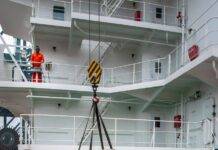
2 Leg Sling Calculation: Ensuring Safe Material Handling
2 Leg Sling Calculation : Handling heavy loads with precision and safety is of paramount importance in various industries, especially in construction and manufacturing. 2 leg slings, an essential component in material handling, play a vital role in ensuring that loads are lifted securely. In this article, we will explore the intricacies of 2 leg sling calculations, providing a comprehensive guide for those involved in the lifting and rigging industry.
I. Introduction
A Brief Overview of 2 Leg Sling Calculations
In essence, 2 leg sling calculations are a set of calculations used to determine the capacity of a sling to lift a load safely. These calculations are essential to avoid accidents, injuries, and damage to materials during the lifting process.
II. Understanding the Basics
What Are 2 Leg Slings?
2 leg slings, also known as double-leg slings, are a type of lifting sling with two legs that are connected to a central point. These slings are commonly used to lift heavy and often irregularly shaped loads. They come in various materials such as wire rope, chain, and synthetic webbing.
Key Components and Applications
2 leg slings consist of two legs, end fittings, and connection points. They are used in a wide range of industries, from construction and manufacturing to shipyards and warehouses, to safely transport and position heavy loads.
III. Importance of Load Calculation
Ensuring Safety in Material Handling
2 leg sling calculations are crucial to guarantee the safety of both the workers and the materials being lifted. Overloading or miscalculating sling capacity can result in disastrous accidents, leading to injuries and costly damages.
IV. Factors Affecting Sling Capacity
Material Type and Strength
The type of material from which the sling is made greatly affects its capacity. Materials like wire rope and chain have high strength and are suitable for heavy loads.
Sling Angle
The angle at which the slings are used significantly impacts their capacity. As the sling angle decreases, the load capacity increases. Understanding the relationship between sling angle and capacity is vital.
Load Weight
The weight of the load being lifted is a fundamental factor in calculating sling capacity. Heavier loads require slings with higher capacity.
Environmental Conditions
Environmental factors such as temperature, humidity, and corrosive substances can impact the material’s strength and the sling’s capacity.
V. The Sling Angle and Its Significance
How Does Sling Angle Impact Capacity?
The sling angle is a critical factor to consider. As the angle between the two legs of the sling decreases, the tension in each leg increases. This means that the capacity of the sling decreases as the angle decreases.
VI. Calculating Sling Capacity
Basic Formula and Steps
To calculate the sling capacity, you need to use the following formula: Sling Capacity = (Leg Length) x (Load Weight) / (Sling Angle Factor).Practical Examples
Here's a sample example of calculating the capacity of a 2 leg sling.Scenario: Lifting a Heavy Machinery Component
Imagine you work in a manufacturing facility, and your team needs to lift a heavy machinery component that weighs 15,000 pounds. You plan to use a 2 leg sling to securely hoist the machinery. To ensure safety and efficiency, you need to calculate the sling’s capacity.
Data for Calculation:
- Load Weight: 15,000 pounds
- Length of Each Leg: 12 feet
- Sling Angle: 60 degrees
Calculation Steps:
- Calculate the Sling Angle Factor (SAF):
- SAF = 2 / sin(60 degrees)
- SAF ≈ 2.3094 (rounded to 4 decimal places)
- Use the formula to determine the Sling Capacity:
- Sling Capacity = (Leg Length) x (Load Weight) / (Sling Angle Factor)
- Sling Capacity = (12 feet) x (15,000 pounds) / (2.3094)
- Sling Capacity ≈ 73,714.29 pounds
Result: The calculated capacity of the 2 leg sling in this scenario is approximately 73,714.29 pounds. This means that the sling is capable of safely lifting the 15,000-pound machinery component with a 60-degree sling angle. It’s important to note that the sling’s capacity exceeds the load weight, ensuring a margin of safety.
By performing this calculation, you can ensure that the 2 leg sling is used within its safe working limits, preventing accidents and ensuring a successful lift.
VII. Safety Precautions
Tips for Safe Sling Usage
- Always ensure that the sling is in good condition before use.
- Conduct regular inspections and maintenance.
- Train your personnel in safe lifting practices.
- Do not exceed the sling’s capacity.
VIII. Inspecting Your Slings
Regular Maintenance and Inspection
Inspect your slings for any signs of wear, damage, or distortion. Replace damaged slings immediately to prevent accidents.
IX. Conclusion
In conclusion, understanding and correctly calculating the capacity of 2 leg slings is essential for safe material handling. Neglecting these calculations can lead to accidents, injuries, and financial losses. By adhering to safety guidelines and conducting regular inspections, you can ensure the safe and efficient use of 2 leg slings.
Web Belt Sling Working Load Limit (WLL)
Types of Crane in Construction
5 Unique FAQs
- What are the common materials used for 2 leg slings?
- The common materials used for 2 leg slings are wire rope, chain, and synthetic webbing. The choice of material depends on the specific requirements of the lifting operation, such as the weight and type of load, environmental conditions, and safety considerations.
- How do I determine the appropriate sling angle for a lifting operation?
- To determine the appropriate sling angle, you should consider the angle between the two legs of the sling. As a general guideline, a larger sling angle (closer to 90 degrees) is preferred because it maximizes the capacity of the sling. However, the exact angle may vary depending on the load and the rigging setup. Always refer to the manufacturer’s guidelines or consult a rigging professional for specific recommendations.
- Are there any regulatory standards for 2 leg sling calculations?
- Yes, there are regulatory standards for sling calculations. In the United States, the Occupational Safety and Health Administration (OSHA) sets standards for safe rigging practices, including guidelines for calculating sling capacity. The American Society of Mechanical Engineers (ASME) also provides standards for rigging and load handling equipment. It’s essential to adhere to these standards to ensure safety and compliance with regulations.
- Can I use 2 leg slings for underwater lifting operations?
- Yes, you can use 2 leg slings for underwater lifting operations. However, it’s crucial to ensure that the slings are designed and rated for submersion in water. Special considerations may be needed for underwater lifting, such as preventing corrosion and ensuring proper drainage to avoid water entrapment.
- What are the key differences between 2 leg slings and single leg slings in terms of capacity and application?
- The primary difference between 2 leg slings and single leg slings is their lifting capacity and application. 2 leg slings, with their two legs and the associated angles, generally have a higher capacity compared to single leg slings. They are commonly used for lifting heavier and bulkier loads that require extra stability. Single leg slings, on the other hand, are suitable for lighter loads and more straightforward lifting tasks. The choice between the two depends on the specific lifting requirements and load characteristics.
























